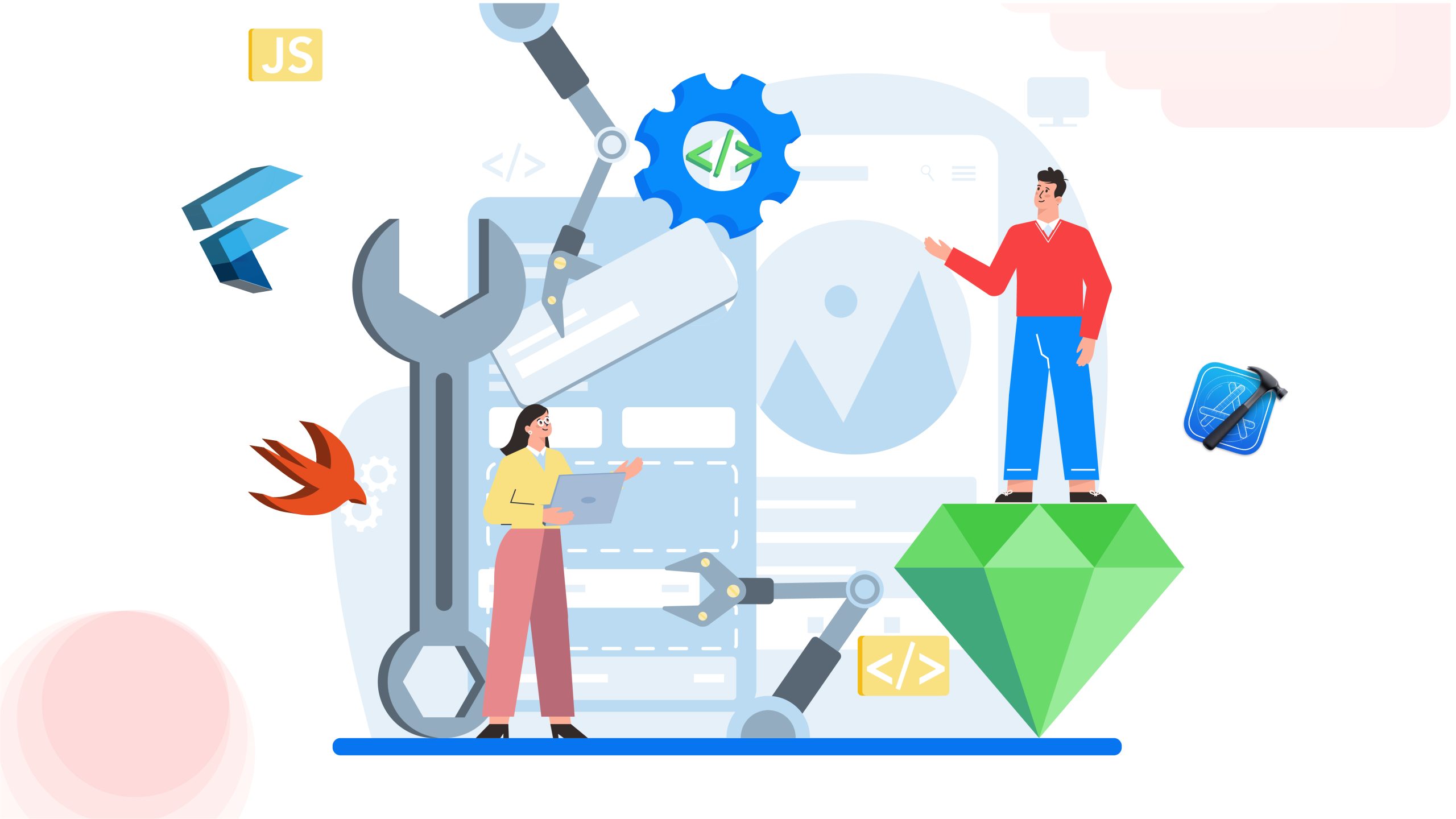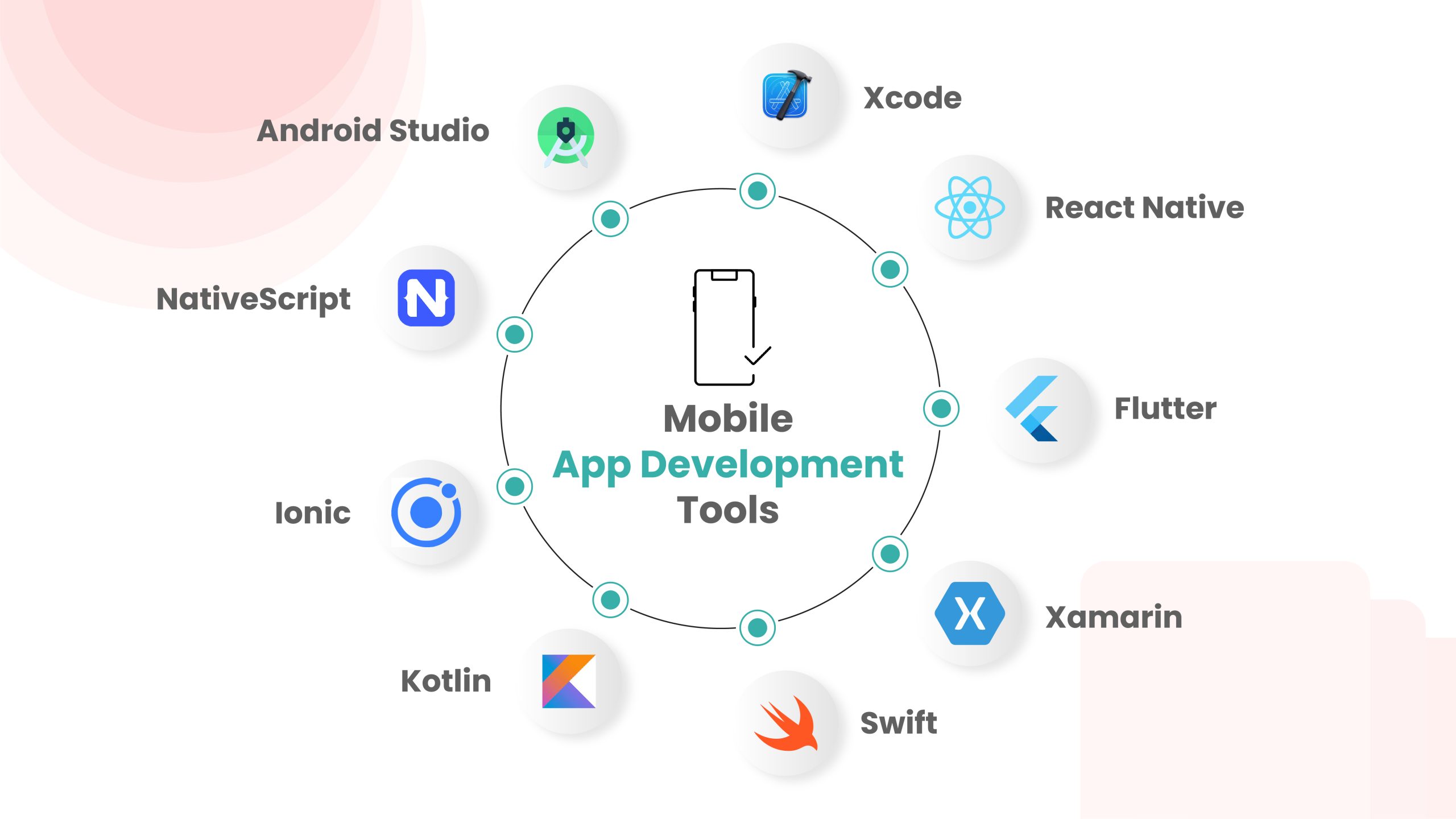App Development Toolbox: Essential Tools for Building Outstanding Apps

Envision, if you will, the overwhelming scenario of embarking on a shopping expedition only to be confronted with an extensive array of one hundred distinct items that all share striking similarities in appearance, texture, and function. Undoubtedly such an experience would leave one feeling enthralled. Yet selecting a mobile app development tool presents an equally demanding challenge. Making a prudent decision promises gratifying benefits that extend far into the future; however. Making an ill-fated choice necessitates commencing anew and incurring additional expenses. Imposing various risks when choosing the wrong technology for your mobile app. The technology you ultimately opt for wields considerable influence over both the quality and abilities of your app.
Relinquishing this chosen technology at a later stage demands a comprehensive overhaul – arduous and steeped in expense. Regrettably. Startups often fail to recognize the significance of scalability within mobile apps. Instead, they prioritize prompt solutions that address immediate needs -a fallacy not conducive to selecting an appropriate mobile app development tool. Before reaching any verdict it is essential to thoroughly analyze your application’s featured facets and prerequisites. Weighing each aspect allows you to choose the aptest tool possessing functions and features that cater precisely to those prerequisites. Additionally.
You should explore seeking consultation from reputed mobile app development companies. These companies boast expertise indispensable for aiding you in making astute choices or even constructing the app on your behalf utilizing tools tailored to meet your specific requirements.
What is a Mobile App Development Tool?
A mobile app development tool is a software or platform that enables developers to create, design, test, and deploy mobile applications for various operating systems such as iOS and Android. These tools provide a set of features, libraries, frameworks, and resources that simplify the app development process and allow developers to build functional and visually appealing mobile applications.
There are several distinct types of mobile app development tools, including frameworks, integrated development environments (IDEs), software development kits (SDKs), and app builders. The extensive development environments offered by IDEs include code editors, debugging tools, and testing emulators or simulators. Software development kits (SDKs) are collections of libraries, documentation, and development aids that aid programmers in writing code, particularly for a given platform or operating system. Frameworks provide pre-built elements and libraries that hasten development by offering functionally-ready features. With the use of drag-and-drop interfaces and ready-made templates, app builders are visual development tools that let users construct apps without writing any code.
These tools assist developers in building native or cross-platform mobile apps, depending on the requirements and target audience. They typically support various programming languages such as Java, Swift, Objective-C, and JavaScript, allowing developers to choose the language they are most comfortable with.
Mobile app development tools play a crucial role in streamlining the app development process, reducing development time and costs, and providing developers with the necessary resources to create feature-rich and user-friendly mobile applications.
Best Mobile Development App Tools to be Used in 2023
It’s important to note that the mobile app development landscape is constantly evolving, and new tools emerge regularly, so it’s recommended to research and stay updated on the latest trends and advancements in the field. Here are some notable mobile app development tools:

- React Native: React Native has gained significant popularity due to its ability to build cross-platform mobile apps with a native-like user experience. It utilizes JavaScript and the React framework to create reusable UI components that can be rendered natively on iOS and Android platforms. One of the key advantages of React Native is its “learn once, write anywhere” approach, which allows developers to leverage their existing web development skills and apply them to mobile app development. This reduces development time and effort by enabling code sharing between platforms. Additionally, React Native has a large and active community that contributes to its extensive ecosystem of libraries, tools, and resources.
- Flutter: Flutter, a Google invention, has drawn notice for its quick development and attractive UI features. It makes use of the Dart programming language and offers a wide variety of pre-built widgets, enabling programmers to design user interfaces that are both aesthetically pleasing and incredibly adaptable. The “hot reload” feature of Flutter enables programmers to observe changes in real-time, accelerating development and enabling quick iteration. Flutter’s innovative rendering strategy that renders UI elements directly to the canvas offers exceptional speed and makes it possible for apps to have a unified look and feel across various devices. It’s a popular option for creating aesthetically pleasing mobile apps thanks to its responsive structure and a large collection of widgets.
- Xamarin: With the help of Xamarin, a division of Microsoft, programmers can create native mobile applications for the iOS, Android, and Windows platforms. With Xamarin, developers can share a sizable part of code between platforms, cutting down on the amount of time and work required for development. Developers can create high-speed apps with a native look and feel thanks to Xamarin’s access to platform-specific APIs and native performance. Its connection with the potent IDE Visual Studio boosts productivity and makes testing and debugging simple. Developers can construct shared UI code across platforms with the help of Xamarin. Forms, a UI toolkit offered by Xamarin, further optimizes the development process.
- Swift: Swift is a robust and user-friendly programming language created by Apple for the creation of apps for iOS, macOS, watchOS, and tvOS. It provides contemporary syntax, security improvements, and performance enhancements. Because it allows for the writing of clear and expressive code, Swift has grown in popularity among iOS developers. This makes the process of creating apps more effective and less prone to mistakes. Swift’s type safety and memory management capabilities boost performance and dependability. With Swift, developers can take advantage of Apple’s vast ecosystem and the most recent iOS features and frameworks, ensuring their apps are current and platform-optimized.
- Kotlin: For the creation of Android apps, Kotlin is an officially supported programming language that was created to work in tandem with Java code already in use. Developers may write more concise and reliable code with its powerful language features, null safety, and succinct syntax. Due to its increased efficiency and improved developer experience, Kotlin has become widely used among Android developers. Developers can take advantage of features like coroutines for asynchronous programming, extension functions, data classes, and an expressive type system with Kotlin. Because Kotlin and Java are completely compatible, programmers can use Java libraries and frameworks in their Kotlin projects.
- Ionic: With the help of the open-source framework Ionic, developers can create cross-platform mobile apps using web technologies like HTML, CSS, and JavaScript. With Ionic, developers can produce app interfaces for iOS, Android, and progressive web apps that closely match native experiences. It offers a comprehensive library of pre-built UI elements, themes, and plugins, making it simpler to make engaging and aesthetically pleasing mobile apps. Ionic seamlessly integrates with well-known web frameworks like Angular, giving developers access to a stable and scalable development ecosystem. Ionic also provides a command-line interface (CLI) for quick deployment options, efficient debugging tools, and effective development.
- NativeScript: JavaScript, TypeScript, or Angular can be used by developers to create native mobile apps using NativeScript. It gives developers direct access to native APIs, allowing them to make apps with powerful platform-specific functionality. Developers can save time and work by writing code only once and then deploying it to several platforms using NativeScript. The framework offers a wide range of UI elements that make it easier to design intuitive and visually appealing user interfaces, including themes and layouts that can be customized. Additionally, NativeScript provides for easy connection with JavaScript libraries already in use, offering developers more freedom and extensibility when creating apps.
- Android Studio: The official integrated development environment (IDE) for creating Android apps is called Android Studio. It was created by Google and offers a full complement of tools to speed up the creation of apps. A feature-rich code editor with intelligent code completion, refactoring, and debugging features is provided by Android Studio. Its visual layout editor enables developers to create and evaluate live prototypes of app interfaces. Apps may be tested on a range of screen sizes and configurations thanks to the built-in emulators and device profiles. Performance profiling tools for optimizing memory use and app performance are now included in Android Studio. It allows developers to select their chosen language for creating Android apps since it supports Java, Kotlin, and C++.
- Xcode: Xcode is the official IDE for iOS and macOS app development. It provides a complete set of tools for designing, developing, and debugging iOS and macOS apps. Xcode includes features like Interface Builder, which allows developers to visually create user interfaces, and the SwiftUI framework for building app interfaces using declarative syntax. It offers an integrated testing environment for running unit tests and UI tests. Xcode also includes performance analysis tools to optimize app performance and memory usage. With support for Swift and Objective-C programming languages, Xcode caters to developers’ preferences and allows seamless integration with Apple’s frameworks and APIs.
It’s crucial to take into account project needs, development team knowledge, platform support, performance considerations, community support, and ecosystem maturity when choosing a mobile app development technology. You may choose the finest tool for your particular app development needs by carefully weighing these variables to help you make an informed decision. To take advantage of new tools and technologies that are developed in the business, it is also essential to keep up with the most recent trends and developments in the field of mobile app development.
